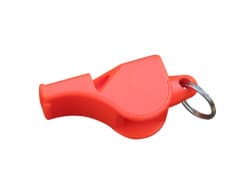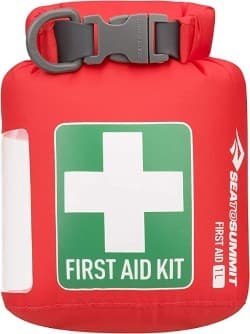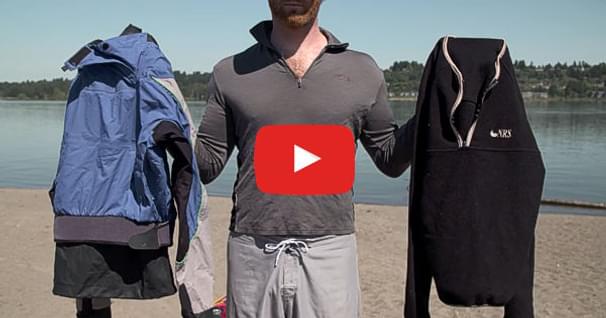10 SUP Safety Equipment Essentials

Stand Up Paddling is a great and fun way to explore the world on the water while getting a bit of exercise. Once you get the hang of it you might even think you can just grab your board and paddle and venture into the great unknown. While this sounds romantic, it is important you consider your safety before paddling out. After all, the weather and water can change in an instant, turning a beautiful day into a dangerous one.
The best way to ensure you are never in a dangerous and potentially life-threatening situation while SUP boarding is by making sure you are prepared. This means bringing along all the essential safety equipment you need for your adventure. While not every paddling excursion requires the same safety equipment, we compiled a list of 10 SUP safety essentials that every paddle boarder should have in their arsenal so they can rest assured they are ready for any scenario.
10 SUP Boarding Safety Essentials
1. SUP Leash
Every SUP board should have some sort of leash attached to it. After all, these boards aren’t cheap, and the last thing you want is to watch it float away with the wind or downstream, lost forever. In addition to keeping tabs on your investment, a SUP leash also keeps you safe.
You might plan on staying dry, but often life on a SUP board has other plans. When you find yourself unexpectedly in the water you want your board nearby so you can reach it quickly and mount it. Swimming with your SUP paddle in one hand is not easy, keeping your board nearby is essential in order to keep you safe on your board.
2. PFD
You can’t mention SUP safety without personal floatation devices (PFD). PFDs are essential to keeping you safe during any water sport. You can either go with a buoyancy aid, which helps keep you afloat (but does not prop your head up when you are unconscious), or the safer option of a life jacket.
Regardless of which type you choose, when it comes to SUP boarding with a PFD you want to make sure you choose something that keeps you safe but doesn’t interfere with your paddle or getting on the board. So opt for a PFD without too many buckles and zippers on the front that can potentially interfere with your board when mounting it. Also see if you can find a fitted PFD that won’t rub on your arms when you are stroking the paddle.

3. UV Protection
One danger that you can’t necessarily see but is always there is UV light. Sunscreen and other protective UV clothing and equipment is essential for any SUP border. After all, SUP adventures can last anywhere from 1 hour to all day, often with no shade.
So find a reliable sunscreen that is long-lasting and waterproof. Consider a wide-brimmed hat with a secure strap. Also make sure you have UV protection and polarized sunglasses so you don’t damage your eyes with that reflecting water.
4. A Dry Bag To Protect Equipment
Every water sport enthusiast should have a few dry bags. Sometimes a dry bag can even hold some essential safety equipment. For shorter journeys you might not need a full-blown survival kit, but keeping your phone with GPS and emergency contacts dry is definitely important for your wellbeing. You can also pack some energy snacks, even duct tape for those “just in case” moments.
Reliable Dry Bags For Safety: Earth Pak - Waterproof Dry Bag
5. Proper Clothing
Some people hop on a SUP board and paddle out with little thought of what they are wearing or where they are going. This is not wise. Always think through your wardrobe choices before you set out on your SUP voyage.
Investing in waterproof clothing, especially during the colder months, is a smart idea. Make sure you are aware not only of the air temperature, but also the water temperature. You don’t want your body to drop to a dangerous temperature on a cold day paddling out.
6. Flashlight
If you are paddling out far or any time in the later afternoon for that matter, always bring a flashlight, headlamp, or some other form of visual signaling device. Make sure your flashlight is airtight and waterproof.
Flashlights serve several purposes. For one, they can help alert others of your presence to keep boats or other boarders from getting too close when it gets a bit darker. They also help you see what is in front of you, which is very important when paddling in after sunset.
Best Waterproof Headlamp: AMAKER LED Rechargeable Headlamp
7. Compass Or GPS
Even when you have a meticulously mapped out route, it is still possible to find yourself lost. Being lost in the open water can be a humbling and even terrifying experience. But this panic will quickly subside if you have a reliable GPS or at least a compass with you.
For situations like these, it is great to have a smart watch with GPS. These waterproof smart devices are reliable ways to get you back on track. Best of all, since they are on your wrist, they are easy to use and access while paddling. It’s also a good idea to keep an eye on the time anyway, so the daylight doesn’t escape you.
8. Safety Whistle
Just as it is important to have a visual signaling device, you should also have an auditory signalizing device. While this does not mean you need to pack a fog horn every time you paddle out into a bay, you should have a whistle at the very least.
A safety whistle is a cheap and small device that can save your life. It is an effective way to send out a distress call if you are in trouble. Your whistle is also great at alerting nearby boats, paddlers or swimmers of your presence if they are distracted.

9. A Helmet
While not necessary in placid sandy waters, there are some instances where you will want to bring a helmet along for your SUP ride. Any time you plan to venture out on a rocky river, or into rapids you should absolutely strap on a helmet. There is no telling when or where you might lose balance and fall.
Wearing a helmet can protect you from head injury, and most importantly it can help keep you from being rendered unconscious after a fall.
10. Quick Release Belt
Another important piece of safety equipment for those going into rougher and fast moving water is a quick release belt. A leash might work in the majority of situations, but when water moves fast and your board could get snagged or caught, which can pose a dangerous situation for you when you are attached to it. So an easily accessible quick-release belt makes it simple to detach yourself and float to safety.
Safety Equipment For Longer Adventures
First Aid Dry Kit
If you are taking a longer paddle, or leading a group paddle expedition, you will want to increase your amount of safety equipment. This includes strapping on an emergency first aid kit dry bag. These kits are sometimes available for purchase already stocked and in a water-proof container, or you can stock your own. You can add anything additional you think might be helpful, like aloe vera creme or specific medication. Either way, when you are venturing long distances or with a big group, it is important to be ready for anything.
Buy A First Aid Dry Sack: Sea ToSummit View Dry Sack With First Aid Markings

Survival Shelter
For Those on a long distance paddle, in addition to a first aid kit, you can also pack an emergency shelter. These are compact but very helpful shelters that can, in a pinch, provide you with a safe place to shelter while you await for sunlight or better weather. While not necessary on shorter paddles, they are certainly recommended on longer SUP adventures, especially in areas where weather can get particularly extreme.
Extra Paddle
Another safety precaution worth considering on longer expeditions, especially when you plan on being far from shore for a period of time, is a backup paddle. After all, if you are far from shore and your paddle breaks, you are going to struggle to paddle to safety with just your arms to lead the way.
You can consider a three-piece detachable paddle, as these collapsible paddles become quite compact and can easily fit underneath a bungee cord on the board.
Our Collapsible Paddle Recommendation: Red Paddle Co Cruiser Tough Small 3-Piece Adjustable Stand Up Paddle
Concluding Thoughts On Essential SUP Safety Equipment
SUP boarding is an activity that is pretty safe as far as watersports are concerned. It is also a great low-impact exercise that helps you get a great cardiovascular workout without putting undue strain on your body. But just because hopping on your SUP board feels carefree, it doesn’t mean you shouldn’t take the time to bring along the necessary safety equipment. Some safety equipment, like a leash and PFD should be no-brainers. But when you venture out on longer paddles, or in waters that are unfamiliar to you, take the time to make sure you have all the applicable pieces of safety equipment to ensure a safe and seamless return to shore.
Related Articles
Being on the water, exposed to Mother Nature, means when things do go wrong, they can go very wrong,…
When you're out on the water, you have to take into account two important factors — the…
Harbors and marinas have plenty of protected water to explore, and can be great places to launch a small…
By Claudia Kerckhoff Van WijkDirector, Madawaska Kanu Centre The "Canadian" on this page is not…



